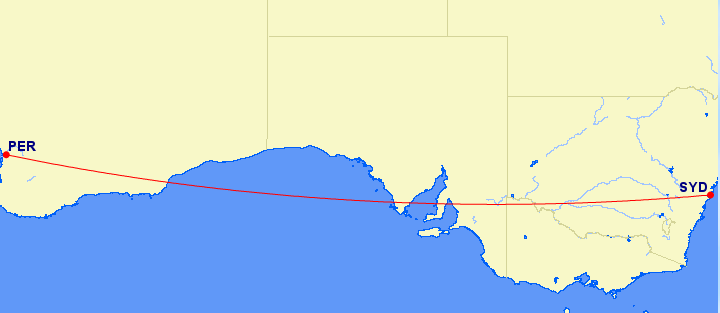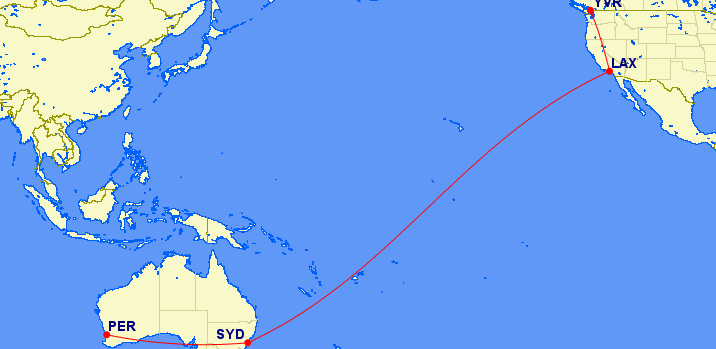This September, I’ll be going to Christmas Island. However, I’ll be arriving in Sydney and departing to Christmas Island from Perth. This means that I needed to figure out how to get between Sydney and Perth.
Most of the articles I read about intra-Australia travel rush straight to using British Airways Avios for award tickets on Qantas. This can often be good value but it’s not always. Avios can be a terrible value, too! Instead, I’ll walk you through the process that I followed and the calculations I made which led me to use a different program.
The first thing I always check is the cash price of a ticket so I can calculate the value of a redemption. Like any comparison I don’t compare the same exact flights, but use comparable flights to find the lowest fare. Not surprisingly, given the length of the transcontinental flight, it’s expensive to fly between Sydney and Perth. I had specific dates and times I needed to fly, and the cash price on Virgin Australia was $324. This was actually pretty good. The cheapest price in the market was $296, and this didn’t include a checked bag, which I’ll need. So the Virgin Australia fare really was the best deal.

Points Options
On paper, I had two options to spend points on this flight. Delta and Singapore Airlines both partner with Virgin Australia. However, the flight times I needed weren’t available with points. Additionally, both charts are really expensive; it would have cost 45,000 SkyMiles or 40,000 KrisFlyer miles to book the roundtrip. This would yield less than 1 cent per point in value.
I could also book the Virgin Australia flight through the Chase portal. With my Chase Sapphire Reserve, the price would be 21,600 Ultimate Rewards points. This wouldn’t have been a bad deal; there’d be no cash out of pocket and I’d earn a handful of Delta SkyMiles for the trip. However, I’d be taking a risk: my positioning flight would be on an airline with frequent operational challenges (Virgin Australia is known for great inflight service, but also for unreliable operations), and I wouldn’t be able to check my bags through to my final destination. Accordingly, for my return flight, it’d mean that I’d either have to cut my day short in Perth, or I’d be taking a risk.
The similarly timed Qantas flight was a better, less risky option for the schedule I wanted. This is an overnight flight that allows for a 4 hour connection in Sydney, and for which there is no available backup flight. Why was it lower risk? Qantas allows interlining across their own flights. So, if you have two separate Qantas tickets on a connecting itinerary, you can present both tickets when you check in at your originating city, and they’ll issue boarding passes all the way through and check your bags all the way through. This reduces the risk of flying on multiple tickets. If your first Qantas flight is delayed, you are much less likely to be stranded in the connecting city because you can more easily make a tight connection (you won’t have to claim your bags and check in again).

Qantas also has special, unpublished rules for when a revenue ticket is combined with an award ticket. They understand that people often have to buy positioning flights for use with award tickets. Ordinarily, these rules apply when the short-haul segment is a revenue flight, but there is nothing in the rule that says that the long-haul segment can’t be part of the combination instead. What are the rules? Well, they’re unpublished, so nobody really knows, and they could change at any time. However, in practical terms, if you check in on time, check your bag through, and have boarding passes for your entire journey, Qantas will treat the entire itinerary as “checked in.” This means that if your Qantas flights are delayed or cancelled in a way that breaks your itinerary along the way, Qantas will reroute you on other flights to get you where you’re going. This can, in some circumstances, also apply to Oneworld award ticket combinations.
Booking Award Flights On Qantas
The specific flights I wanted were available as economy class award tickets on Qantas, and I had multiple ways to book them.
Using British Airways Avios, the price was 25,000 miles plus $34.20 in tax. That “sweet spot” that other blogs have beaten to death (often while selling British Airways credit cards) for intra-Australia flights is a sour spot with long flights like these, which are really expensive on the Avios distance-based chart. British Airways Avios charges no booking fees, however, yielding a relatively straightforward (but very poor) 1.15 cents per mile in value relative to a comparable flight.
Using Alaska Airlines Mileage Plan, the mileage cost and taxes were the same as British Airways Avios. On top of taxes, however, Alaska Airlines charges a $25 “partner booking fee” per roundtrip, making them the most expensive option. The effective cents per mile received here is 1.06, which is terrible value for Alaska Airlines Mileage Plan miles. I average 2.4 cents per mile in “real” value for these points (although I have gotten a consistent 15 cents per mile in “sticker price” value for Cathay Pacific First Class redemptions).
And then, almost as an afterthought, I looked at my American AAdvantage points bank. American has a terrible program for Seattle-based travelers. Availability is extremely limited from the West Coast to anywhere using their program (most award flights require one or two inconvenient connections) so I am constantly struggling to spend my AAdvantage miles in an optimal way. American typically doesn’t open up availability until the last minute, so they can charge you a $75 close-in booking fee (sucking most of the value out of the program). The miles are relatively easy to accrue (with multiple credit card partners offering generous sign-up bonuses), but they’re super hard to spend in any optimal way.
I don’t book much intra-Australia award travel, and most of it is short-haul (for which either cash or Avios are best), so I was surprised to see that there is an incredible sweet spot in the award chart: it’s just 10,000 miles for intra-Australia flights of any length. As the holder of an Barclays Aviator card, I was further entitled–through the end of the statement cycle when I cancelled the card–to a 10% discount on this redemption. This meant that I spent only 18,000 AAdvantage miles roundtrip for the flight, yielding a value of 1.61 cents per mile.
Wrap-Up
The value I received for my AAdvantage miles is by no means spectacular, but I value cash more than devaluing, hard-to-spend points and the value beat the 1.5 cents per point I would have gotten from Chase Ultimate Rewards. It also beats the 1.4 cent per point TPG valuation for AAdvantage points, which–if anything–I consider generous. More importantly, it de-risked my itinerary by keeping the return on Qantas. While the “sleep at night” factor is hard to measure, there is a real value to this as well.
When you’re booking intra-Australia flights, don’t just run to an overly-promoted sweet spot. Look at all of the options.
Want to fly with miles to Australia or anywhere else? AwardCat can help!
